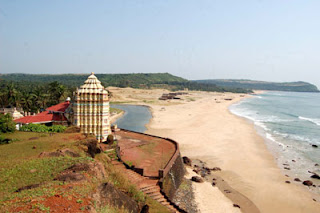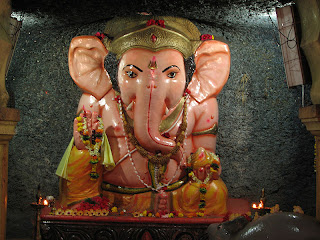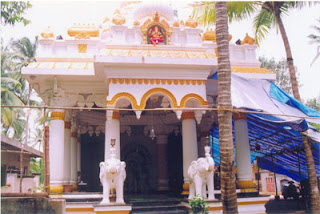 |
| Kunkeshwar Temple |
Kunkeshwar Temple
It is famous both as a picturesque holiday resort and a religious place. The elaborately carved Kunkeshwar Temple was built around 1100 AD, by the Yadava rulers. Visited frequently by Chatrapati Shivaji, the temple is considered as a fine example of contemporary sculpture. Kunkeshwar is also renowned for its coconut, palm and mango plantations and a variety of seafood. Southwards along the coast, beyond the creek at Mumbri, is a lovely walk all along the rocky slopes. It ends at the temple of Kunkeshwar, a lonely stretch of sand that simply sparkles in the sunlight. The temple can be approached by the road that branches off at Jamsande. | Rameshwar Temple (Achara) |
Rameshwar Temple (Achara)
Lord Rameshwar is the tutelary deity of Achara village. A unique tradition observed here is that once in five years, the village seeks the divine verdict of Lord Rameshwar and the occasion called `Gavpalne` takes place. In this ritual, all the villagers and their domesticated animals have to reside outside the village for nearly three days. The belief is that the villager`s life will be protected from all risks by Lord Rameshwar`s mercy. The temple offers devotees a 10 room residency in its spacious courtyard which resembles the popular temples of Goa.  |
| Angnewadi (Shree Bharadi Devi) |
Angnewadi (Shree Bharadi Devi)
Goddess Bharadidevi of Angnewadi village is renowned all over. It is believed that her image has occurred in a self existent rock form. The Goddess is said to fulfil the wishes of any person who asks for her favour. Once in a year devotees from Maharashtra, Goa and Karnataka come together in a village for pilgrimage. According to tradition, the Goddess is offered `Otti` (Coconut and Blouse Piece). According to ritual, the devi is adorned with a mask, saree and ornaments, and the offering of Otti commences after this and it is continued throughout the day of the fair. The local people who are entitled to honour and respect come and sit together in a temple on a Dali (Mat Made up of Bamboo) and decide a day of for holding a fair. The women from different households cook food after their bath, and the food is offered as Prasad to the Devi. This Prasad is called Tat Lagne. The prasad is then distributed among the pilgrims who show their presence in thousands during the fair day.  |
| Redi Ganapati |
Redi Ganapati (Redi Village)
This place is situated to the southwest of Sawantwadi. Around 18 years ago, a local person called Sadashiv Kambli visualised the sculpture of Lord Ganesha in his dreams. Following this he persisted in his search of the idol for a long time till at last he found it along the seashore. After survey, it has become evident that the sculpture was made by the Pandavas during the time of their rule. The idol is about 6 feet in height and 4 feet wide, and the entire idol was discovered un-destroyed and as a whole. |
| Jay Ganesh Temple |
Jay Ganesh Temple
Situated at Malvan Jay Ganesh temple is now on a ‘must see’ list of tourists. The temple is built by Shri Jayantrao Salgaonkar, an astrologer of repute and creator of very popular almanac ‘Kalnirnay’. Situated in Medha locality of Malvan on ancestral family land of Salgaonkars, the temple has been constructed as per the holy principles of temple architecture in India. Shri Jayantrao personally supervised the construction. The presiding deity in the temple is Lord Ganesha, much revered Elephant God of Maharashtra. The idol is of pure gold. This main idol in the sanctum sanctorum is in the traditional pose with Riddhi- Siddhi (consorts of Lord) on both sides. Siddhi is holding Dhol (Indian traditional percussion instrument) and sword in her hand while Riddhi has pen and paper in her hands. The hall has eight idols of Ganesh carved in the ceiling. One gets a very comfortable feeling of Lord Ganesh looking benevolently from all the eight directions at his disciple. The interior of the temple is very rich and has used soothing colors. A five-day annual festival of Ganesh Jayanti is celebrated on 4th Day of Magh (month in Hindu Calendar). This day is also the anniversary day of the temple. The speciality of this temple’s architecture can be seen on the early morning of Makar Sankranti (14th or 15th of January). On this day the early sunrays fall directly on the idol and one can see the glittering and shining Ganesha bathed in sunlight. Jayantrao Salgaonkar has named this Ganesha as Jay Ganesha so that the Ganesha may bestow ‘Jay’ (success) on his disciples.
![]()
If you like this please Link Back to this article...












0 comments:
Post a Comment
Note: Only a member of this blog may post a comment.